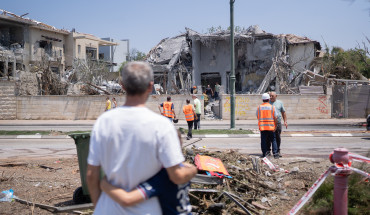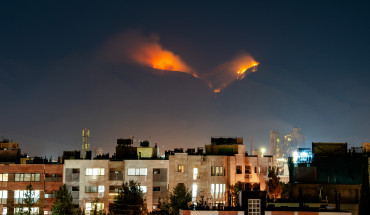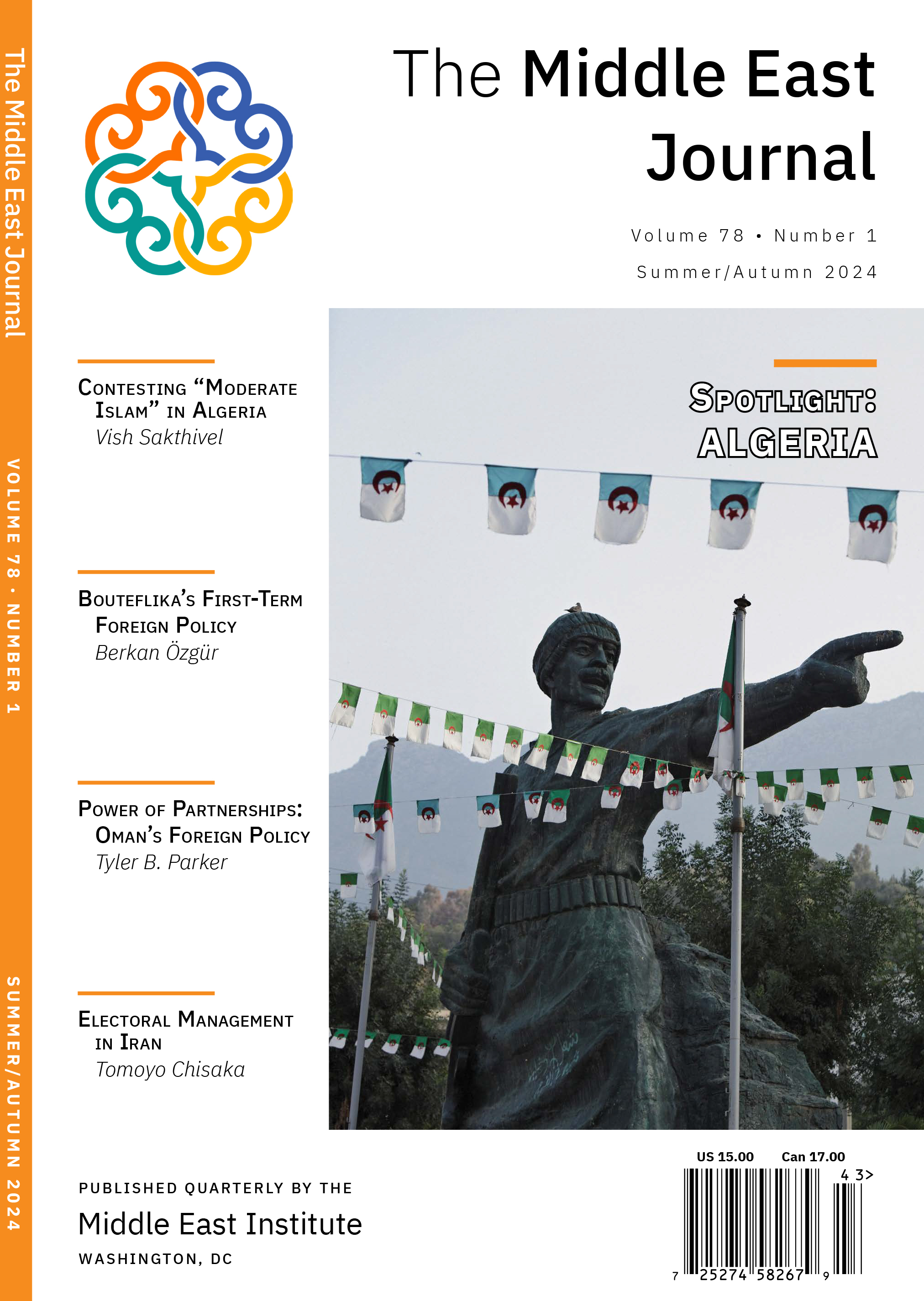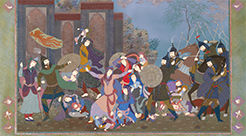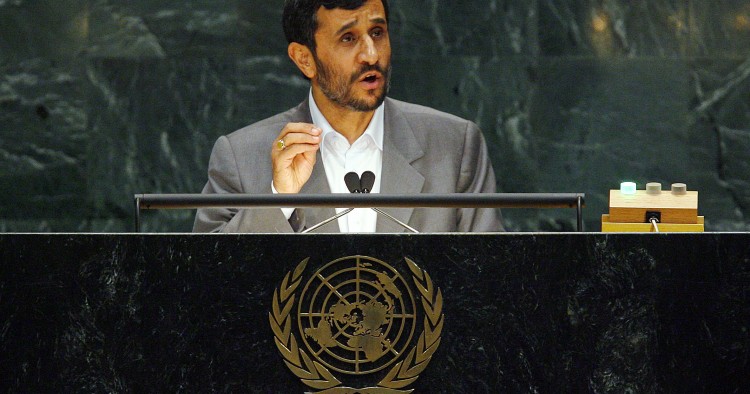In the fall of 2007, President Mahmud Ahmadinejad welcomed President Vladimir Putin on the first state visit by a Russian leader since Joseph Stalin came to Iran to attend the Tehran Summit in 1943 along with Franklin D. Roosevelt and Winston Churchill. The Iranian press was in no doubt as to the significance of the visit, which for many illustrated not only Iran’s importance but its return to the world stage as a power with which to be reckoned. If the press commentary echoed aspirations more commonly associated with the pre-Revolutionary monarchy, a more startling symbol of continuity soon became apparent. As the two Presidents took their positions for the official welcome and opening press conference, observers were faced with a backdrop constructed to look like the Achaemenid Persian guards that adorned the ruined walls of Persepolis.
The celebrated site of the ancient Persian ceremonial capital had remained popular within the Iranian consciousness, though it had been kept at arm’s length by the official ideologues of the Islamic Revolution. For them, Persepolis was tainted not only by the fact that it represents pre-Islamic Iran, but perhaps more crucially because of its close association with Muhammad Reza Shah Pahlavi. Few would have dared to exploit the symbolism as explicitly as Ahmadinejad — an unambiguous statement that Iranian nationalism, always a staple of the social consciousness, had returned to the political stage.
Yet it is also remarkable how few have noticed the significance of the transformation taking place in the Islamic Republic of Iran. To be sure, Iranian nationalism has never been far beneath the political surface, although at the onset of the Islamic Revolution it tended to be buried within layers of Islamicized rhetoric. While many have debated the relationship between religion and nationalism, and particularly the importance of Shi‘ism to the development of a specifically Iranian identity, there has perhaps been less appreciation of the process by which religion has effectively been nationalized over the last 30 years, such that now more than ever we can talk of an “Iranian Shi‘ism.” There has been a tendency in the West to essentialize the Revolution, to view it through an Arab or Islamic prism, and above all to see it as unchanging. There are obvious pedagogic reasons for this, such as the need to simplify a complex and at times bewildering political dynamic. But at the same time, it does little justice to the reality of social change.
The ideologues of the Islamic Republic did not dismiss nationalism. Instead, they sought to define nationalism in such a way that it would play a subservient role to the dominant Islamic narrative. However, this proved to be difficult. With the onset of the Iran-Iraq War in 1980, it became apparent that the people could not be mobilized by religion alone. Confronting an Iraqi regime that had a clear interest in defining the struggle in ethnic rather than sectarian terms, the Islamic Republic was quick to adapt. The “nation” became sacred.
The impact of the eight-year war, along with the dramatic growth in literacy, the emergence of a truly mass media, and the consequent rise in political consciousness, all encouraged a vibrant popular discussion of the nature of national identity and the meaning of being Iranian. Some of this related to notions of development, especially reflections on under-development. Of equal, if not greater importance was the relationship between religion, specifically Islam and identity. Some have interpreted this development simply as the reaction of society against the oppressive Islamic dogma of the state. While this interpretation has some validity, it tends to disguise the role played by the state, if only inadvertently, in harnessing this transformation. It was, for example, the Islamic Republic that encouraged its acolytes to research the history of early Islam in Iran. It was these very devotees of revolution who began to uncover realities that were at odds with the dominant orthodox narrative promoted by the new Islamic Republic. As in the case of students of religious history in the West, it was a short step for the acolytes of the Islamic Republic from studying the history of Islam to contextualizing that history. By extension, this development was more complex than a simple return to the equally dogmatic and somewhat stale state ideology of the Pahlavis. Indeed, one of the real strengths of this rediscovered nationalism was the pluralistic character and the intensity of the intellectual debates it engendered.
As Ahmadinejad’s press conference revealed, while the Achaemenids had enjoyed a gradual if emphatic rehabilitation in the eyes of the state, what was now different was the intellectual depth of the debates, and the crucial fact that in this case, the state was more often than not responding to social sentiment. Moreover, it wasn’t simply the Achaemenids who were basking in a new-found attention; it was the entire social and culture milieu of the Iranian world prior to the rise of Islam along with a reassessment of its legacy for the world of Islam. Through the decade of the 1990s to the present, there has been a gradual synthesis of the various narratives of Iranian history — drawing on developments in modern historiography and the rehabilitation of traditional mythologies of descent as encapsulated in the national epic, the Shahnameh (Book of Kings). It is a view of Iran’s place in the world which has been reinforced by the apparent reality of the growth of Iranian influence in the region. This renewed Iranian national project is ongoing and far from complete. Like all developing ideologies, it is inconsistent and contradictory. President Ahmadinejad has been the most blatant in his exploitation of this sentiment, and there is little doubt that the ruling elite will seek to harness and control it. However, history suggests that this may not be as easy as they may think.
The Middle East Institute (MEI) is an independent, non-partisan, non-for-profit, educational organization. It does not engage in advocacy and its scholars’ opinions are their own. MEI welcomes financial donations, but retains sole editorial control over its work and its publications reflect only the authors’ views. For a listing of MEI donors, please click here.






